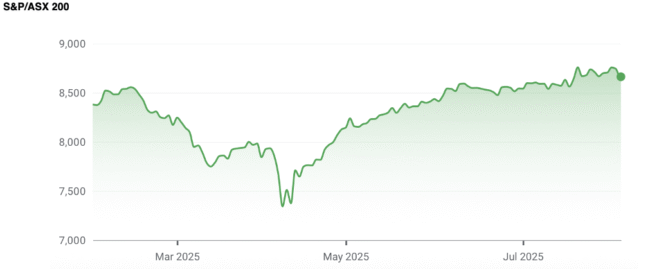Major errors in US statistics for the number of jobs created is a new curve ball bound to be another challenge for stock markets. I’ve been holding back my own cash and that of my financial planning clients. Now I’m going to wait and see how this recession talk plays out. While my playbook for investing short term is to watch the market reaction this week, what’s my long-term play?
Just when I thought it was safe to go into the ‘water’ (call it the stock market) with fresh cash after Donald Trump hit us ‘kindly’ with only a 10% tariff and has been registering other tariff deals with the likes of the EU, the UK, Japan and South Korea, a lurking threat to my plan to ‘swim with more stock purchases’ surfaced. Meanwhile, China and Mexico have been given 90-day extensions to come up with an acceptable agreement on trade with the US. And to date, Wall Street and global stock markets such as ours have given what has become called the TACO trade for Trump Always Chickens Out, the thumbs up.
Of course, Trump fans say it’s all part of his grand plan and it’s not chickening out. I think they’re majorly right. That said, this US President was shown what stock and bond markets can do when he goes in too hard and threatens worldwide trade and the global economy. As a consequence, the Trump playbook since markets went ‘stir crazy mad’ after the Liberation Day tariffs were showcased has been good enough to spark a huge comeback for stocks.

While our market has wacked on close to 18% after the tariff U-turns from Trump in April, since mid-June smart players have waited for the August 1 deadline to be reached. Given the President’s reasonableness, we should have been poised for another leg up, but a new curve ball has been thrown at investors that’s bound to be a new challenge for stock markets in and around all-time highs.
That curve ball was the July US jobs report on Friday that showed a weaker-than-expected rise in employment, with only 73,000 new positions showing up in the labour market when economists expected 100,000. But that’s not the end of it and it gets worse.
For June, statistics for the number of jobs created were revised down from 147,000 to an unbelievably low 14,000! On seeing this number, I thought: “Some US statistician should lose a job or be given a new calculator on that huge revision.”
In fact, President Trump sacked Erika McEntarfer, Commissioner at the US Bureau of Labor Statistics, after seeing this revised number along with the May result that went from 125,000 to 19,000.
These numbers saw the US-based abcNEWS come out with the following headline: “Disappointing jobs report fuels recession worries and calls for interest rate cut”.
Of course, Trump also ripped into Fed boss Jerome Powell for not giving the economy a rate cut or two. On these numbers, Donald does have the central banker over a barrel.
Undoubtedly, Powell would blame all the President’s tariffs for this potential job market problem, but while these two guys deal with each other, big markets players are bound to be less enthusiastic to buy shares.
All four US indexes were off solidly on Friday, with the Nasdaq Composite off a big 472 points (or 2.24%). It could get worse for our market this afternoon if Dow futures point to a tough day at the office for Wall Street.
With this information, I’m glad I’ve been holding back my own cash and that of my financial planning clients, awaiting the fallout from the August 1 deadline tariffs. Ironically, they may be ready to go to put cash to work but now I’m going to wait and see how this recession talk plays out.
My playbook for investing now is to watch the market reaction this week. I’ll wait for a small sell-off and see it as a buying opportunity. I suspect the market will be nervous until either the Fed cuts interest rates or the talk gets so convincing that buying will start ahead of a cut.
US economic data this week will be poured over to see if recession talk is over-the-top and premature, and this kind of second-guessing about what the Trump tariffs have done to consumers, business investment and confidence.
These job market revisions could be the canary in the coal mine for the US economy or a temporary response to the uncertainty that the Trump tariffs have delivered.
So, while my short-term play is to wait and see, I do believe the market will rebound on the following:
- Interest rate cuts
- The good current reporting season
- Artificial Intelligence
- Trump will cut taxes and go for deregulatory changes.
- China will surprise doubters.
On this last point, investment analyst Klyzza Lidman from UK-based Aubrey Capital Management has recently returned from China and penned a paper entitled: China: Recovering Under the Radar?
She makes these points about a new and improving China:
- There’s a rebound in select tech and consumer names (e.g. Xiaomi, Gambol, Eastroc).
- There’s a growing relevance of AI, automation, and robotics in China’s industrial landscape.
- There are diverging fortunes of SMEs amid shifting export dynamics and tariff pressures.
- And high-quality, growth-oriented companies are navigating the current uncertainty better than others.
Long-term, I want to be investing in EX20, BHP, CSL, S32 and VEU, which gives me access to Europe and Asia. And for the US, I want to be more inclined to support active fund managers, such as WCMQ, Hyperion’s HYGG, Munro’s MCGG and Antipodes’ AGX1, who will identify companies either unaffected by Trump’s tariffs or will be beneficiaries of his curve ball plays!
And I suspect, the December quarter could be a good one if I’m on the money with the pluses that should help stocks, once recession fears are hosed down.

